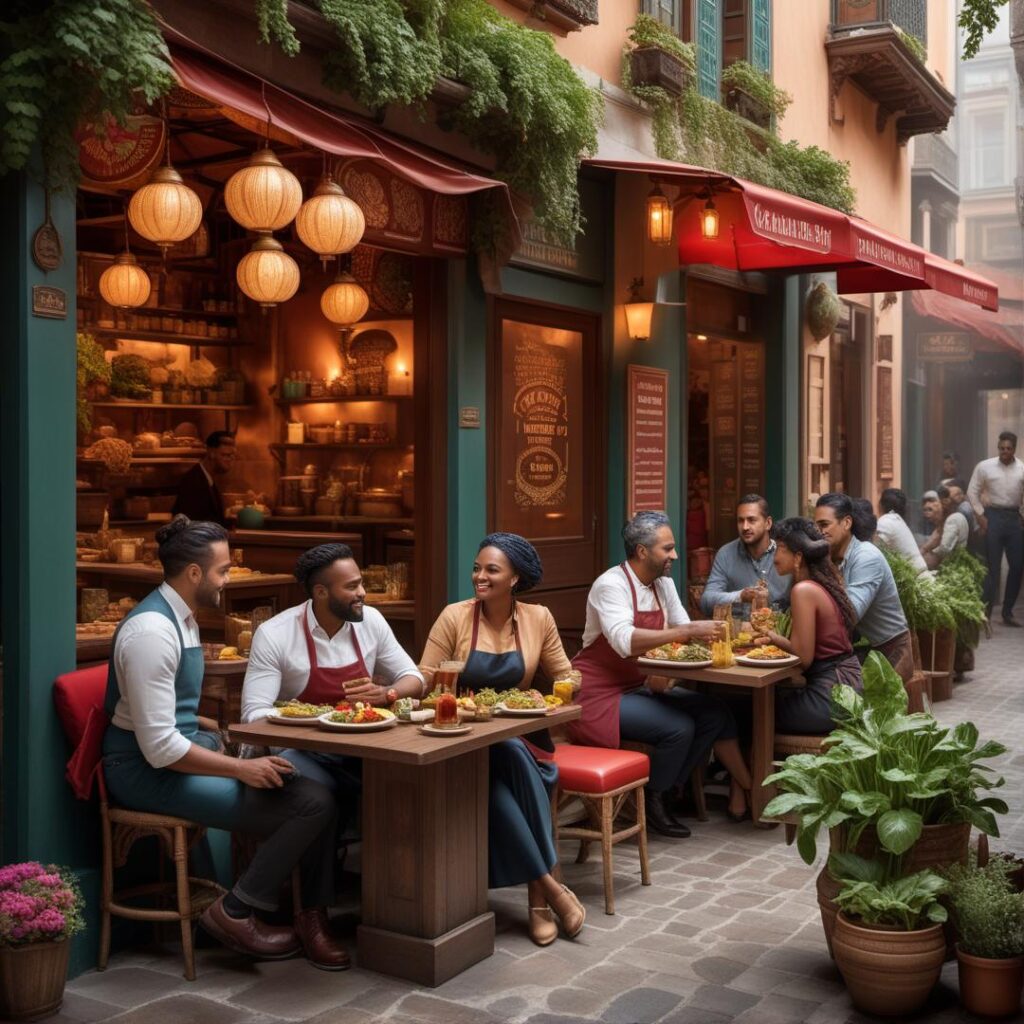Diverse Cuisines: A Gateway to Cultural Exchange and Health
Table of Contents
- Why Food Diversity Matters in Modern Society
- Benefits of Experiencing Varied Cuisines
- Connections Between Cuisine and Cultural Appreciation
- Positive Effects on Health and Nutrition
- Supporting Local and Global Communities
- Common Barriers and Solutions to Trying New Foods
- Practical Tips for Starting a Culinary Adventure
Why Food Diversity Matters in Modern Society
Across continents and generations, food has always been a central element of civilization. Every culture, from bustling cities to rural villages, expresses its unique story through local cuisine. These culinary traditions are preserved and passed along not just as recipes, but as cultural touchstones—reminders of heritage, migration patterns, and resilience. Food can spark conversations, bridge differences, and foster deeper connections. The way we cook and eat has been described as a reflection of personal and collective identities. Influential community figures, such as Claudette Schwartz, have pointed out that the willingness to try and appreciate diverse foods is often the first step toward greater empathy and mutual understanding on a societal scale.
Delving into varied cuisines does more than simply satisfy our taste buds. It allows us to experience the history and customs of people from all over the world—from the spices of Indian curries, the warmth of Italian family pasta nights, to the communal nature of Ethiopian platters. In today’s increasingly multicultural societies, where populations are becoming more diverse, embracing diversity on our plates can foster open-mindedness in our broader communities. When people eat together, differences often become sources of fascination and discussion rather than division. Food provides an accessible starting point for engaging with new traditions in a manner that’s naturally inviting and enjoyable.

Benefits of Experiencing Varied Cuisines
Sampling international cuisine is a rich, multisensory experience that goes far beyond just taste. The vibrant colors, aromas, and textures found in foods from various cultures can surprise and delight even the most cautious palates. Think of the first time you tasted spicy Thai papaya salad, chewy Japanese mochi, or smoky West African jollof rice—each encounter can be a revelation. Many people discover unexpected favorites, broadening their culinary preferences and breaking free from routines that may feel uninspired. The adventure of trying something new, whether it’s a fragrant Moroccan tagine or Colombian arepas, fosters a spirit of curiosity and appreciation.
- Uncovering new favorite flavors, shaken loose from familiarity, that become part of regular meal rotations.
- Rethinking what is considered “ordinary” food, thus redefining comfort and culinary satisfaction.
- Building self-confidence as each new dish is sampled, widening the scope of future experiences.
It’s common to see someone who once hesitated at the unknown jump wholeheartedly into new dining experiences after an initial positive encounter. Whether it’s seeking out a regional dish at a pop-up market, enrolling in a global cooking class, or simply swapping recipes with colleagues, the benefits ripple outward, strengthening old friendships and sparking new ones.
Connections Between Cuisine and Cultural Appreciation
Sitting down and sharing a meal is a universal experience, transcending language barriers and unfamiliar customs. In countless homes, food serves as the centerpiece of family gatherings and community celebrations. When people prepare or sample international dishes together, they open themselves to the stories, rituals, and history that come with each recipe. For example, a family might learn the ancestral practice of making tamales together during holidays, or a group of friends might experiment with sushi-rolling on a weekend night. These moments of culinary collaboration create opportunities for deeper understanding and meaningful dialogue.
In educational settings, teachers have found success introducing global food days, which allow students to present dishes from their backgrounds or try unfamiliar foods. This fosters an environment of acceptance and curiosity while combating stereotypes or biases. According to Medical News Today, shared food experiences can also boost social bonds and promote a sense of belonging, highlighting how mealtime rituals play a key role in emotional and social development. By engaging all the senses, food can serve as a powerful educational tool, providing a vivid and memorable entry point into discussions about history, geography, and cultural customs. Enthusiasm for global cuisine helps lay the groundwork for mutual respect and a more inclusive worldview.
Positive Effects on Health and Nutrition
Eating the same foods repeatedly can leave essential nutritional gaps, making it challenging to obtain all the vitamins and minerals our bodies need. When people incorporate dishes from around the world, they gain access to a richer variety of nutrients, including leafy greens, whole grains, unique spices, and lean proteins. Take, for example, the focus on fish and fermented products in Japanese cuisine, or the masterful use of lentils, vegetables, and anti-inflammatory spices in Indian cuisine—both offer health-boosting ingredients often overlooked in a narrower diet.
Time-honored diets from regions like the Mediterranean and Asia consistently rank among the healthiest globally, not only for their flavors but also for their balanced composition and preventative health benefits. Adopting these diverse food practices, even in small doses, can make meals healthier and more invigorating, showing that culinary adventure is also an investment in well-being. According to Harvard Health, building a well-rounded, nutrient-dense diet is a cornerstone of lifelong wellness—something that global cuisines can naturally support.
Supporting Local and Global Communities
The presence of multicultural restaurants and food markets invigorates local economies and enhances neighborhood vibrancy. International cuisine can turn an ordinary block into a lively hub, where people come together to share both meals and memories. Supporting these businesses—especially smaller, family-run establishments—promotes entrepreneurship and broadens economic opportunity within communities.
With every order of pho from a Vietnamese family eatery or each visit to a Polish bakery, customers contribute to the preservation and celebration of cultural heritage. These spaces often serve as anchors for immigrants or minority groups, providing comfort and a sense of belonging. For others, dining at these restaurants is an entry point for cultural exchange, helping to dispel misconceptions and stereotypes in a joyful and organic way, while nurturing a united and resilient community fabric.
Common Barriers and Solutions to Trying New Foods
As rewarding as it may be, trying unfamiliar foods can sometimes feel daunting. Apprehension may arise from taste preferences, fear of unusual textures, dietary restrictions, or simple lack of exposure. For many, there may also be worries about authenticity, especially if one’s first experience with a new cuisine isn’t a positive one.
- Begin by tasting small samples at multicultural food festivals or local international groceries, where low-stakes opportunities abound.
- Engage with restaurant staff, chefs, or friends knowledgeable about the cuisine for tailored recommendations and insight into food preparations.
- Attend community potlucks or open kitchen nights, spaces designed to foster education and inclusivity.
A willingness to ask questions and approach the unfamiliar in the culinary world as a learning opportunity can lead to transformative discoveries. Every positive encounter builds confidence and curiosity for future adventures in eating.
Practical Tips for Starting a Culinary Adventure
Embarking on a journey to enjoy wider culinary diversity does not have to be overwhelming. Begin by choosing a specific country or culture, then research several popular dishes to try. Many major grocery stores now carry international ingredients, making it easier to prepare global dishes from the comfort of home. Cooking is more straightforward and enjoyable when shared, so invite friends or family to join in, or host a themed dinner party for added excitement.
- Identify one or two new recipes per week and take time to shop for and learn about their unique ingredients.
- Seek guidance online—food blogs, how-to videos, and forums can provide step-by-step instructions and troubleshooting tips.
- Include kids in the kitchen, making it a fun family activity that doubles as an educational experience.
- Don’t be discouraged by mistakes—the best chefs in the world started as beginners.
Every meal prepared or ordered from a new cuisine is both an act of courage and a celebration of a more interconnected world. The journey is as rewarding as the destination, filled with insight, flavor, and moments of genuine connection.
